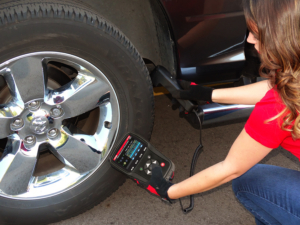Back to the news page
05.14.2018
Educating Customers on the Importance of Measuring Tire Tread Depth to Increase a Shop’s Bottom Line
Over time, it is normal for the tread on tires to wear. Checking the tread depth and wear on each tire will let you know when the tire needs to be replaced, or if other regular maintenance should be involved get the most out of your tires and vehicle.
As tires lose their tire tread, they also lose their ability to grip the road, which can cause the driver to lose control of the vehicle. Proper tire tread is crucial as precipitation escapes or compresses through the tread’s grooves to maintain as much contact with the road surface as possible.
In the United States, tire tread is measured in 32-nd of an inch. Most all-season passenger vehicle tires are 9/32 to 11/32- inch. In most states, 2/32-inch is the minimum tread depth requirement, which means by law, drivers are required to replace a tire when a tire wears down to that depth.
 Measuring tire tread depth
Measuring tire tread depthThe “Penny Test” – Most people have heard of the “penny test”. Just place a penny with Lincoln’s head upside-down in between the grooves of the tread between the tread ribs. If you see Lincoln’s entire head, it means you should replace the tire.
Tire tread wear bars – Within the tread grooves are tire tread wear bars so you can visually see if you’ve reached 2/32-inch. If the tread ribs show the indicator bars, it means the tire should be replaced.
Tire Tread Depth Gauge – It is important for customers to purchase a tire tread depth gauge and to track their tire tread at least once a month. However, shops should use a professional tire tread depth gauge with the most accurate measurements and proper calibration.
Tires are a significant investment for customers. Shops should educate their customers on why their tires are being replaced, possibly prematurely, to build a trusting relationship and create a repeat customer for years to come. Tires are one of the most important aspects of a vehicle, and maintaining proper tire tread depth can increase a vehicle’s fuel efficiency and increase the overall value of the tire.
Some professional tire tread depth gauges, such as the ATEQ Tire Tread Depth Gauge, allow information to be printed, stored or transferred to keep for repeat customers. All of these advantages using a professional tire tread depth gauge can bring opportunities for an increase in tire and TPMS services during routine tire maintenance.
There are many causes for tire failure on a road, and shops should educate their customers on the top causes for tire tread wear.
Overall, it is important for shops to use a professional tire tread depth gauge to properly measure your customers tire tread when servicing tires as well as educate the customer on tire tread wear. Be sure to show your customer the printed tire tread depth measurement results, as well as measurement data from past visits to the shop. This communication and education about tire tread wear will build trust and keep them coming back from regular checkups, increasing your bottom line. Your customers will appreciate the increase of value from their tires, as well as an increase of safety and security of their vehicle.
Learn more about the ATEQ Tire Tread Depth Gauge
ATEQ explains the importance of TPMS training in new...
ATEQ TPMS is proud to announce the TTD- Tire Tread D...
The tread depth can tell you a lot about what is goi...